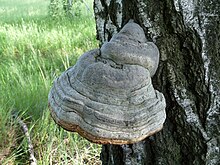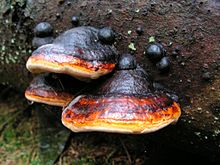Fomes fomentarius
| Fomes fomentarius | |
|---|---|

| |
| Scientific classification | |
| Domain: | Eukaryota |
| Kingdom: | Fungi |
| Division: | Basidiomycota |
| Class: | Agaricomycetes |
| Order: | Polyporales |
| Family: | Polyporaceae |
| Genus: | Fomes |
| Species: | F. fomentarius
|
| Binomial name | |
| Fomes fomentarius | |
| Synonyms | |
| |
Fomes fomentarius(commonly known as thetinder fungus,[3]false tinder fungus,hoof fungus,[3]tinder conk,tinder polyporeorice man fungus) is a species offungalplant pathogenfound in Europe, Asia, Africa and North America. The species produces very largepolyporefruit bodieswhich are shaped like ahorse's hoofand vary in colour from a silvery grey to almost black, though they are normally brown. It grows on the side of various species of tree, which it infects through broken bark, causingrot.The species typically continues to live on trees long after they have died, changing from aparasiteto adecomposer.
Though inedible,F. fomentariushas traditionally seen use as the main ingredient ofamadou,a material used primarily astinder,but also used to make clothing and other items. The 5,000-year-oldÖtzi the Icemancarried four pieces ofF. fomentarius,concluded to be for use as tinder. It also has medicinal and other uses.
Taxonomy[edit]
The first scientific description of the fungus appeared in the literature in the 1753Species PlantarumbyCarl Linnaeus;he called itBoletus fomentarius.[4]Thespecific epithetfomentariusis from theLatinfomentum,referring totinder.[5]The species has been described as a member of numerous different genera. In 1783,Jean-Baptiste Lamarcknamed the speciesAgaricus fomentariusin hisEncyclopédie Méthodique: Botanique.[6]In 1818,Georg Friedrich Wilhelm MeyerdescribedPolyporus fomentariusin hisPrimitiae Florae Essequeboensis,[7]and this name wassanctionedbyElias Magnus Friesin the 1821 publication of the first volume of hisSystema Mycologicum.[2]Fries later, in his 1849Summa vegetabilium Scandinaviae,moved the species to the genusFomes.Subsequent attempts to change the genus of the species have been unsuccessful; the species was namedPlacodes fomentariusbyLucien Quéletin 1886,Ochroporus fomentariusbyJoseph Schröterin 1888 andScindalma fomentariumbyOtto Kuntzein 1898. In the twentieth century,Narcisse Théophile Patouillardnamed the speciesUngulina fomentariain 1900, andWilliam Murrilltwice reallocated the species; in 1903, he named itElfvingia fomentariaand in 1914, he named itElfvingiella fomentaria.In 1963,Shu Chün Tengnamed itPyropolyporus fomentarius.These names are considered obligate synonyms; that is, different names for the same species based on a single description or specimen. In addition to the obligate synonyms, there are a number of taxonomic synonyms, whereby names have been described as separate species, but have come to be considered synonymous.[2]The species iscommonly knownas the tinder fungus, hoof fungus,[3]tinder polypore, ice man fungus[8]or false tinder fungus.[9]
Description[edit]


Fomes fomentariushas afruit bodyof between 5 and 45 centimetres (2.0 and 17.7 in) across, 3 and 25 cm (1.2 and 9.8 in) wide and 2 and 25 cm (0.8 and 9.8 in) thick,[3]which attaches broadly to the tree on which the fungus is growing.[10]While typically shaped like ahorse's hoof,it can also be morebracket-like with anumbonateattachment to thesubstrate.[10]The species typically has broad, concentric ridges, with a blunt and rounded margin.[10]Thefleshis hard and fibrous, and acinnamonbrown colour.[3]The upper surface is tough, bumpy,[10]hard and woody,[3]varying in colour, usually a light brown or grey. The margin is whitish during periods of growth.[10]The hard crust is from 1 to 2 mm (0.04 to 0.08 in) thick, and covers the tough flesh.[11]The underside has round pores of a cream colour when new, maturing to brown,[10]though they darken when handled.[3]The pores are circular, and there are 2–3 per millimetre. The tubes are 2 to 7 mm (0.08 to 0.28 in) long and a rusty brown colour.[3]
The colouration and size of the fruit body can vary based on where the specimen has grown. Silvery-white, greyish and nearly black specimens have been known. The darkest fruit bodies were previously classified asFomes nigricans,but this is now recognised as a synonym ofFomes fomentarius.The colour is typically lighter at lower latitudes and altitudes, as well as on fruit bodies in theNorthern Hemispherethat grow on the south side of trees. However, studies have concluded that there is no reliable way to differentiatevarieties;instead, thephenotypicdifferences can "be attributed either to different ecotypes or to interactions between the genotype and its environment".[12]
Microscopic features[edit]

The spores are lemon-yellow in colour, and oblong-ellipsoid in shape. They measure 15–20 by 5–7μm.The species has a trimitic hyphal structure (meaning that it has generative, skeletal and bindinghyphae), with generative hyphae (hyphae that are relatively undifferentiated and can develop reproductive structures) withclamp connections.[3]
Similar species[edit]
Fomes fomentariuscan easily be confused withPhellinus igniarius,species from the genusGanodermaandFomitopsis pinicola.An easy way to differentiateF. fomentariusis by adding a drop ofpotassium hydroxideonto a small piece of the fruit body from the upper surface. The solution will turn a dark blood red if the specimen isF. fomentarius,due to the presence of the chemical fomentariol.[13]
Habitat and distribution[edit]
Fomes fomentariushas acircumborealdistribution, being found in both northern and southern Africa, throughout Asia and into eastern North America,[14]and throughout Europe,[12]and is frequently encountered.[15]The optimal temperature for the species's growth is between 27 and 30 °C (81 and 86 °F) and the maximum is between 34 and 38 °C (93 and 100 °F).[16]F. fomentariustypically grows alone, but multiple fruit bodies can sometimes be found upon the same host trunk.[3]The species most typically grows uponhardwoods.In northern areas, it is most common onbirch,while, in the south,beechis more typical.[14]In theMediterranean,oakis the typical host.[12]The species has also been known to grow uponmaple,[12]cherry,hickory,[8]lime tree,poplar,willow,alder,hornbeam,[14]sycamore,[3]and even, exceptionally,softwoods,[14]such asconifers.[12]
Ecology[edit]

Fomes fomentariusis astem decayplant pathogen.The species'myceliumpenetrates the wood of trees through damaged bark or broken branches, causing rot in the host.[13]It can grow on the bark wound, or even directly onto the bark of older or dead trees.[11]The decayed wood shows black lines in the lightly coloured decayed areas; these are known as pseudosclerotic layers or demarcation lines.[13]The lines are caused byenzymescalledphenoloxidases,converting either fungus or plant matter intomelanin.The lines are not an absolute identifier, as they can also occur in plants infected byKretzschmaria deustaand someArmillariaspecies.[13]Despite beginning as a parasite, the species is able to survive for a time (hasteningdecomposition) on fallen or felled trees as asaprotrophicfeeder,[17]and typically lives there for years, until the log is completely destroyed.[18]It is also capable of colonising and breaking downpollengrains, giving it a second food source which is particular high innitrogen.[13]Infected trees become very brittle,[19]and cracks can occur in the affected tree due to wind.F. fomentariusis particularly adept at moving between cracks on the tree without interruption.[18]However, in addition to the obviously infected damaged trees,F. fomentariusis known to be anendophyte,meaning that healthy trees which are not sportingF. fomentariusfruit bodies could still be infected.[8]
The fruit bodies areperennial,surviving for up to thirty years. The strongest growth period is between early summer and autumn.[14]The yearly growth always occurs on the bottom of the fungus, meaning that the lowest layer is the youngest. This occurs even if the host tree has been laid on the forest floor,[20]which can happen because of thewhite rotinduced by the fungus. This is a process known as positivegravitropism.[21]Very large numbers of spores are produced, particularly in spring, with up to 887 millionbasidiosporesan hour being produced by some fruit bodies. Spore production also takes place in autumn, though not nearly as heavily.[12]The spores are released at comparatively low temperatures.[22]In dry weather, the spores are visible as a white powder.[11]
Uses and importance[edit]

The species is not considerededible;[3][10]the flesh has an acrid taste, with a slightly fruity smell.[3]The fungus has economic significance; it depreciatestimbervalue as the parasitic infection advances.[23]Fomes fomentariusinfects trees through damaged bark.[11]
Amadou[edit]
This species, as well as others such asPhellinus igniarius,can be used to makeamadou,a material used astinder,[24]among other purposes. Amadou is produced from the flesh of the fungus fruit bodies.[14]The young fruit bodies are soaked in water before being cut into strips, and are then beaten and stretched, separating the fibres. The resulting material is referred to as "red amadou".[24]The addition ofgunpowderornitreproduces an even more potent tinder.[14][24]The flesh has further been used to produce clothing, including caps, gloves and breeches.[13]Amadou was used medicinally by dentists, who used it to dry teeth, and surgeons, who used it as astyptic.It is still used today infly fishingfor dryingflies.[25]Other items of clothing and even picture frames and ornaments have been known to be made from the fungus in Europe, particularlyBohemia.[26]The fungus is known to have been used as a firestarter inHedeby,[14]and it is known that the fungus was used as early as 3000 BCE. When found, the 5,000-year-oldÖtzi the Icemanwas carrying four pieces ofF. fomentariusfruit body.[27]Chemical tests led to the conclusion that he carried it for use as tinder.[28]
See also[edit]
- Piptoporus betulinusalso carried by Ötzi
- Forest pathology
- Ganoderma applanatumknown as the artist's conk
References[edit]
- ^"Fomes fomentarius(L.) J. Kickx f. "Species Fungorum.Retrieved2010-09-16.
- ^abc"Fomes fomentarius(L.) Fr. 1849 ".MycoBank.Retrieved2 January2010.
- ^abcdefghijklmPhillips, Roger (1981).Mushrooms and Other Fungi of Great Britain and Europe.London:Pan Books.p. 262.ISBN0-330-26441-9.
- ^Linnaeus C. (1753).Species Plantarum(in Latin). Vol. 2. Stockholm: Impensis Laurentii Salvii. p. 1176.Retrieved2010-09-16.
- ^Rea, Carleton(1922).British Basidiomycetaceae: a Handbook to the Larger British Fungi.Cambridge University Press.p. 592.
- ^"Agaricus fomentarius(L.) Lam. 1783 ".MycoBank.Retrieved2 January2010.
- ^"Polyporus fomentarius(L.) G. Mey. 1818 ".MycoBank.Retrieved2 January2010.
- ^abcStamets 2005, p. 31
- ^Kirtley, Paul(2011)."The easy way to use Fomes fomentarius as tinder".PaulKirtley.co.uk.Retrieved13 July2014.
- ^abcdefgSterry, Paul; Hughes, Barry (2009).Complete Guide to British Mushrooms & Toadstools.HarperCollins.p. 256.ISBN978-0-00-723224-6.
- ^abcdButin, Heinz; Lonsdale, D. (1995).Tree Diseases and Disorders.Oxford University Press.pp. 167–8.ISBN978-0-19-854932-1.
- ^abcdefSchwarze 2000, p. 59
- ^abcdefSchwarze 2000, p. 61
- ^abcdefghSchmidt 2006, p. 195
- ^Kibby, Geoffrey (2003).Mushrooms and Toadstools of Britain and Northern Europe.Hamlyn.p. 213.ISBN978-0-7537-1865-0.
- ^Schmidt 2006, p. 68
- ^Schmidt 2006, p. 200
- ^abSchwarze 2000, p. 62
- ^Schwarze 2000, p. 26
- ^Schmidt 2006, p. 25
- ^Schmidt 2006, p. 75
- ^Schwarze 2000, p. 40
- ^McCormick, Meghan A.; Grand, Larry F.; Post, Justin B.; Cubeta, Marc A. (2013)."Characterization of species of Fomes Phylogenetic and phenotypic characterization of Fomes fasciatus and Fomes fomentarius in the United States".Mycologia.105(6): 1524–1534.doi:10.3852/12-336.PMID23928420.S2CID20858783– via Taylor & Francis Online.
- ^abcHarding 2008, pp. 159–60
- ^Harding 2008, p. 159
- ^Rolfe, Robert Thatcher; Rolfe, F. W. (1974).The Romance of the Fungus World.Courier Dover.p. 164.ISBN978-0-486-23105-1.
- ^Harding 2008, p. 157
- ^Spindler, Konrad (1995).Der Mann im Eis[The man in ice].Springer.p. 75.ISBN978-3-211-82626-3.
Cited texts[edit]
- Harding, Patrick (2008).Mushroom Miscellany.HarperCollins.ISBN978-0-00-728464-1.
- Schmidt, Olaf (2006).Wood and Tree Fungi: Biology, Damage, Protection, and Use.Springer.ISBN978-3-540-32138-5.
- Schwarze, Francis W. M. R.; Engels, Julia; Mattheck, Claus (2000).Fungal Strategies of Wood Decay in Trees.Springer.ISBN978-3-540-67205-0.
- Stamets, Paul (2005).Mycelium Running.Ten Speed Press.ISBN978-1-58008-579-3.
